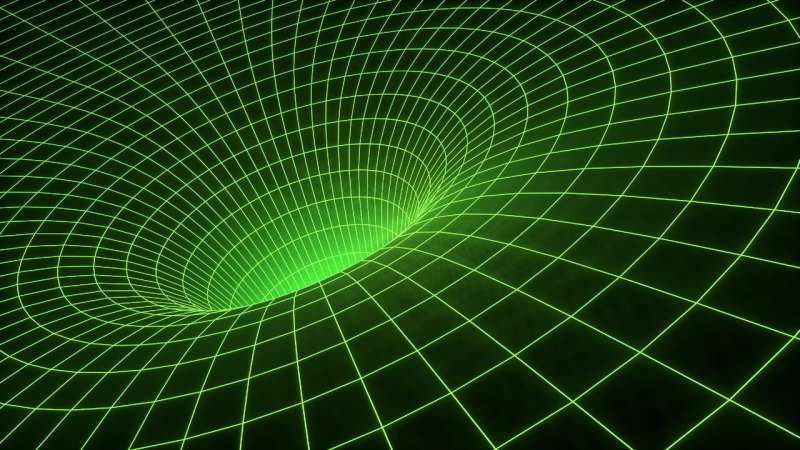This article has been reviewed according to Science X's editorial process and policies. Editors have highlighted the following attributes while ensuring the content's credibility:
fact-checked
peer-reviewed publication
proofread
New measurements of gravitational anomaly at low acceleration favor modified gravity, researcher claims

Wide binary stars as direct probes of the nature of gravity at low acceleration weaker than about 1 nanometer per second squared have been hotly debated. The nature of gravity at such low acceleration is of utmost importance because the concept of dark matter, the gravitational dynamics of astrophysical systems, fundamental theories of physics and cosmology are all inextricably intertwined with it.
For example, a deviation from Newtonian expectation at such low acceleration would require a modification or extension of Einstein's general relativity despite all its successes outside the low acceleration regime.
Two recent independent studies led by Kyu-Hyun Chae and Xavier Hernandez claim that the statistical properties of wide binary stars based on European Space Agency's latest Gaia database deviate from the Newtonian expectation in agreement with the prediction of modified gravity theories under the new theoretical framework called modified Newtonian dynamics (MOND, sometimes referred to as Milgromian dynamics), introduced 40 years ago by Mordehai (Moti) Milgrom.
The breakdown of Newtonian gravity at low acceleration would mean a scientific revolution whose full implications are immeasurably far-reaching. Because of this importance and considering other divergent claims, Chae has carried out a new analysis to address all the issues raised so far, in particular the challenges to the specific low-acceleration gravitational anomaly obtained by himself.
For this, Chae has considered a full range of samples, allowing various fractions of hierarchical systems where a binary has an unseen nested inner binary, and applied various methods that cover essentially all the methods published so far, including the method used by some researchers to claim against the gravitational anomaly.
The study was published in The Astrophysical Journal on 9 September 2024. "To some extent, it was my obligation to the science community to carry out this new work. I had to clarify the issues and challenges raised to my claimed conclusion and explain the causes of the divergent claims by others," says Chae.
Chae found that all methods with various samples give consistent results. The magnitude of the gravitational anomaly first identified last year appears robust.
Chae says, "The gravitational anomaly is clearly imprinted in the data. One cannot remove it. It is mysterious to many scientists why gravity is boosted by about 40% when the internal acceleration between the orbiting pair of stars is weaker than about 0.1 nanometer per second squared. However, the presence and the degree of the gravitational anomaly were, in fact, predicted by MOND or Milgromian dynamics."
Like Newton's universal law of gravitation and Einstein's general relativity, MOND satisfies the universality of free fall (also referred to as the weak equivalence principle) that is known to be first suggested by Galileo Galilei through experiments at the leaning tower of Pisa.
Newton and Einstein go one step further and adopt (unknowingly or knowingly) the strong equivalence principle by which the internal dynamics of a gravitational system falling freely under a nearly constant external field is not affected by the external field. In contrast, MOND does not postulate the strong equivalence principle and considers theoretical possibilities free of it.
Thus, while wide binaries falling freely under the external field of the Milky Way are expected to obey Kepler's laws according to Newton's and Einstein's theories, MOND predicts that the wide binary internal motion deviates from the Newton-Einstein prediction by the degree dictated by the Milky Way's external field strength of about 0.2 nanometers per second squared. That is about 40% as measured by the new study, in agreement with previous results.
While these consistent results are arresting, unlimited reproductions and confirmations are needed for the reported gravitational anomaly to become a true scientific fact. Also, the reported gravitational anomaly will have to be better characterized continually to provide useful constraints on theories.
The eyes of researchers are on new data and better methodologies for that purpose. In particular, existing research results were obtained with only the sky-projected transverse velocities of stars because the line-of-sight velocity components have not yet been precisely measured. Researchers, including Chae, are considering new measurements of the line-of-sight velocities of stars.
The other study, with Hernandez as the lead author, was published in the Monthly Notices of the Royal Astronomical Society.
More information: Kyu-Hyun Chae, Measurements of the Low-acceleration Gravitational Anomaly from the Normalized Velocity Profile of Gaia Wide Binary Stars and Statistical Testing of Newtonian and Milgromian Theories, The Astrophysical Journal (2024). DOI: 10.3847/1538-4357/ad61e9
X Hernandez et al, A critical review of recent Gaia wide binary gravity tests, Monthly Notices of the Royal Astronomical Society (2024). DOI: 10.1093/mnras/stae1823
Journal information: Monthly Notices of the Royal Astronomical Society , Astrophysical Journal
Provided by Sejong University





















